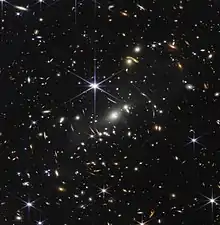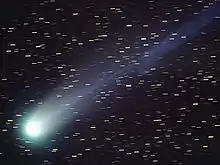| Discovery | |
|---|---|
| Discovered by | Pan-STARRS |
| Discovery date | 26 July 2021 |
| Orbital characteristics | |
| Epoch | 2021-Aug-21 |
| Observation arc | 53 days |
| Number of observations | 279 |
| Orbit type | Oort cloud[1] |
| Perihelion | 0.287 AU[2] |
| Eccentricity | 1.00005 (epoch 1950)[1] 1.002 (epoch 2021)[2] 1.0001 (epoch 2100)[1] |
| Inclination | 56.75° |
| 189.03° | |
| Argument of periapsis | 299.97° |
| Last perihelion | 21 April 2022 |
| TJupiter | 0.446 |
| Earth MOID | 0.062 AU[2] |
| Jupiter MOID | 2.16 AU |
| Comet total magnitude (M1) | 10.6 |
C/2021 O3 (PanSTARRS) is perhaps an Oort cloud comet, discovered on 26 July 2021 by the Pan-STARRS sky survey. It came to perihelion on 21 April 2022 at 0.287 AU (42.9 million km). from the Sun.
The comet was expected to reach apparent magnitude 5 by late April 2022, while being only 15 degrees from the Sun.[3][4] While near perihelion the comet was dimmer than expectations. It was faintly visible in STEREO/SECCHI COR2-A on 27 April 2022.[5] Observations by Lowell Discovery Telescope on April 29 in the twilight detected a diffuse glow with a magnitude of 9 where the comet was expected to be, indicating that the comet nucleus disintegrated during perihelion.[6] C/2021 O3 made its closest approach to Earth on 8 May 2022 at a distance of 0.60 AU (90 million km).[7] As a dynamically new comet from the Oort cloud there was a high risk of disintegration.[8]
The comet was recovered by multiple observatories after perihelion at magnitudes not too different from those observed pre-perihelion.[9] Calculations carried out using the pre- and post-perihelion orbits indicate that although the comet is probably dynamically old, it may also be a fragment of a dynamically new comet that was released during the first perihelion passage of its parent comet.[9]
Orbit

With a short observation arc of 7 days, the Minor Planet Center used an assumed eccentricity of 1.0 for the orbit solution.[10] Due to statistics of small numbers, with a short 10 day arc JPL had an eccentricity of 0.99595±0.00444 which could be as high as 1.00039 or as low as 0.99151.[11] With an observation arc of 53 days, JPL Horizons shows both an inbound and outbound eccentricity greater than 1.[1]
C/2021 O3 probably took millions of years to arrive from the outer Oort cloud and, had it survived, may have been fated to be ejected from the Solar System.[1] This is also the most likely scenario when considering the post-perihelion orbit determination of the surviving object.[9]
References
- 1 2 3 4 5 "JPL Horizons On-Line Ephemeris for 2021 O3 at epoch 1950 and 2100 (barycentric)". JPL Horizons On-Line Ephemeris System. Jet Propulsion Laboratory. Retrieved 29 September 2021. Solution using the Solar System Barycenter. Ephemeris Type:Elements and Center:@0 (To be outside planetary region, inbound epoch 1950 and outbound epoch 2100. Aphelia/orbital periods defined while in the planetary-region are misleading for knowing the long-term inbound/outbound solutions.)
- 1 2 3 "JPL Small-Body Database Browser: C/2021 O3 (PANSTARRS)". Jet Propulsion Laboratory. Retrieved 28 September 2021.
- ↑ "Electronic Telegram No. 5009". Central Bureau Electronic Telegrams. 1 August 2021.
- ↑ "C/2021 O3 ( PanSTARRS )". Seiichi Yoshida.
- ↑ C/2021 O3 (PANSTARRS) was faintly visible
- ↑ Zhang, Qicheng; Ye, Quanzhi; Farnham, Tony L.; Holt, Carrie E. (2 May 2022). "ATel #15358: Disintegration of Near-Sun Comet C/2021 O3 (PANSTARRS)". The Astronomer's Telegram. Retrieved 8 May 2022.
- ↑ "Closest Approach to Earth 2022" (Closest Earth approach occurs when deldot flips from negative to positive). JPL Horizons. Retrieved 2021-09-29.
- ↑ Machholz, Donald (5 May 2022). "EarthSky | Darn! Comet C/2021 O3 PanSTARRS has disintegrated". earthsky.org.
- 1 2 3 Evangelista-Santana, M.; De Prá, M.; Carvano, J. M.; de la Fuente Marcos, C.; de la Fuente Marcos, R.; Alarcon, M. R.; et al. (20 July 2023). "Borderline hyperbolic comet C/2021 O3 (PANSTARRS) was fading as it approached the Sun". Monthly Notices of the Royal Astronomical Society. 524 (2): 2733–2740. arXiv:2307.10029. Bibcode:2023MNRAS.524.2733E. doi:10.1093/mnras/stad2111.
- ↑ "MPEC 2021-P05 : COMET C/2021 O3 (PANSTARRS)] (7-day arc)". Minor Planet Electronic Circulars. Minor Planet Center. 1 August 2021.
- ↑ Archive of JPL #2 (with a 10 day arc)
External links
- C/2021 O3 at the JPL Small-Body Database



.png.webp)